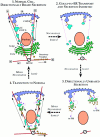Cruising along microtubule highways: how membranes move through the secretory pathway
- PMID: 9508761
- PMCID: PMC2132669
- DOI: 10.1083/jcb.140.6.1277
Cruising along microtubule highways: how membranes move through the secretory pathway
Erratum in
- J Cell Biol 1998 May 18;141(4):1095
Figures

References
-
- Balch WE, McCaffery JM, Plutner H, Farquhar MG. Vesicular stomatitis virus glycoprotein is sorted and concentrated during export from the endoplasmic reticulum. Cell. 1994;76:841–852. - PubMed
-
- Beck KA, Buchanan JA, Nelson WJ. Golgi membrane skeleton: identification, localization and oligomerization of a 195 kD ankyrin isoform associated with the Golgi complex. J Cell Sci. 1997;110:1239–1249. - PubMed
Publication types
MeSH terms
Grants and funding
LinkOut - more resources
Full Text Sources
Other Literature Sources

